Visit Library for MBP Pro eBooks |
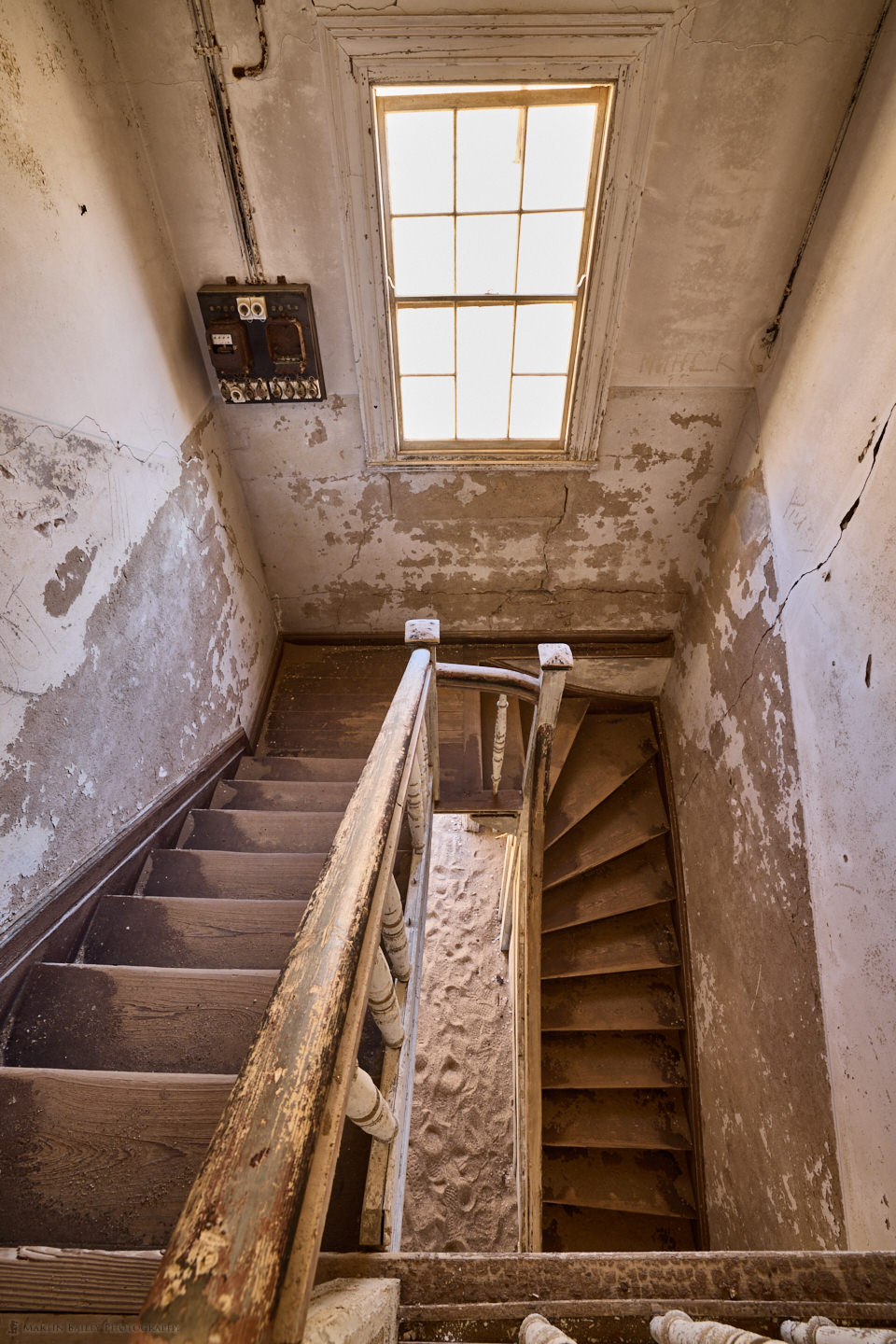
Following on from last week, today we pick up the trail on my recent Complete Namibia tour on the second afternoon in Kolmanskop, the deserted diamond mind town. We have historically been able to do an afternoon, followed by a morning, which helps to get different directions of the sunlight on both days, but they have stopped doing afternoon visits into Elizabeth Bay, so we worked with what we had. It was still great, and most of the opportunities are still available to us.
I started with the Ice Factory, but I’ve shown so many images of that in the past I think we’ll skip it today. I continued by walking up the hill behind the visitors center, where we’d eaten lunch, and shot this next image in the fifth building from the end of the row. Still in relatively good condition, but also with some sand at the foot of the stairs, I like this composition, with the one-point perspective, and a certain amount of symmetry, but also the asymmetry with the stairs on the left coming up closer to the camera and then the banister running from the center along to the right edge.
My wife’s immediate reaction was, “And you, of course, walked up those stairs to get that photo?” probably thinking that I should have gone through them. I must admit, I was slightly nervous, especially as some of the steps gave out an unhealthy groan as I stood on them, but it all worked out OK.
Also, for those of you that are wondering why I allow the window to blow out that way, the reason is that I actually quite like the mystique of not being able to see outside. If I was trying to sell this house, working to architecture photographer’s rules, I’d do an HDR, but as art, I prefer this style of image. The only time you’ll see anything outside a window in my shots here is when the natural light or a little bit of tweaking in Capture One Pro enables me to show it. Otherwise, it’s white windows all the way.
The next image is an example of when we can see outside. The large expanse of missing roof in the Accountant’s House makes it easy to expose for both inside and outside, so we see blue sky and the Namib Desert running across the horizon, as well as the room at the back of the attic and the beams that we can still walk on to get around up here.
I don’t recall why, but I’d let my ISO creep up to 500 for these shots, so my shutter speed was set unnecessarily high at 1/320 of a second at ƒ/11 for this shot. It’s not an issue with today’s cameras, but I’m slightly disappointed in myself here because I’m usually more careful with my exposure. The results balance of course, but not being able to remember why I used these settings is a little bit annoying. I guess I’m not getting any younger though, so you’ll have to forgive me for not being able to keep up with myself from time to time.
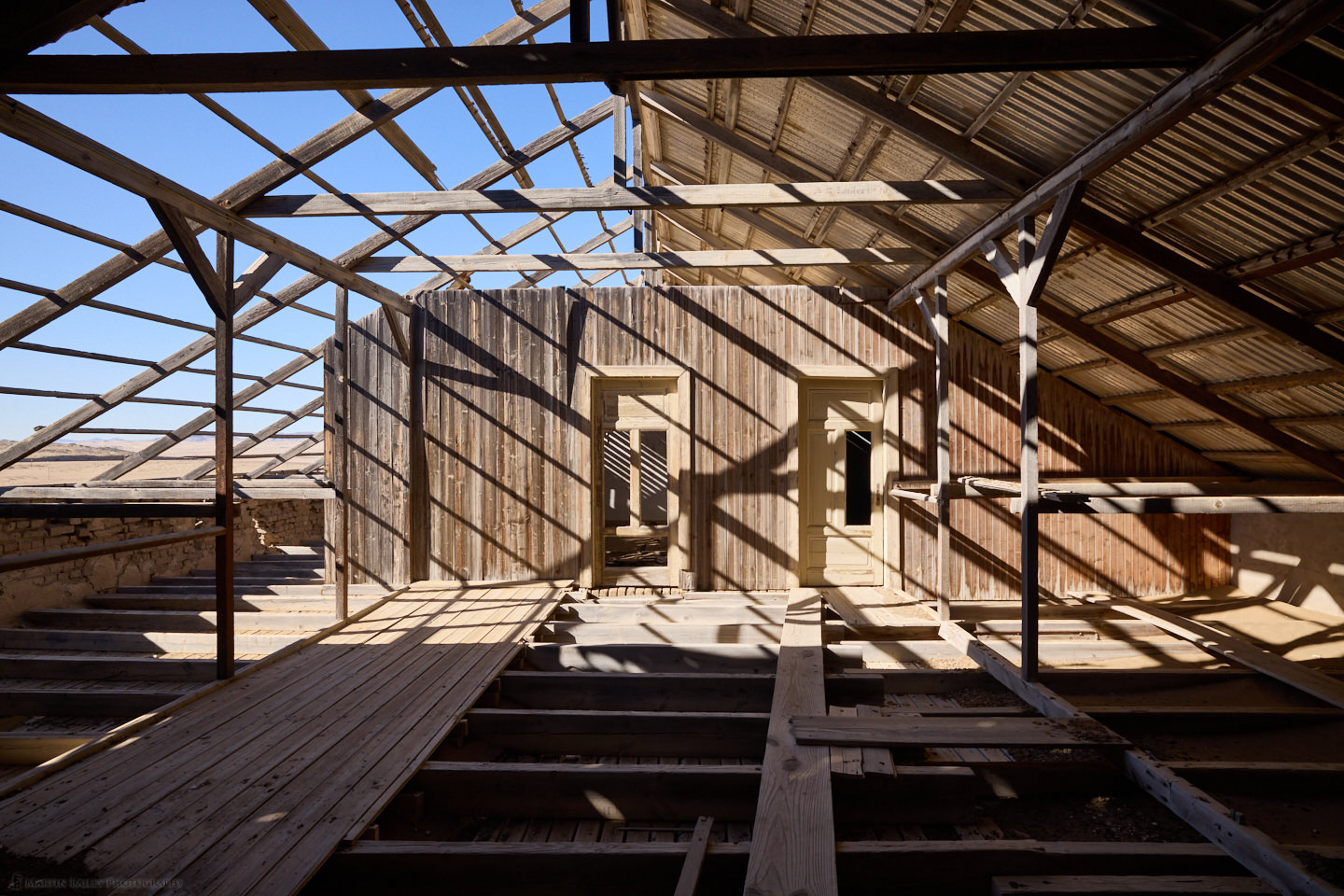
Here’s another relatively famous shot from Kolmanskop, with the sand-filled room and the bathtub. I included the door to the room, open, yet stuck in the sand, because I find these jarred open doors really appealing. I don’t know where the bathtub was originally fixed, but it seems to be almost surfing the sand now, and the broken tree branch, looks almost like a piece of driftwood, afloat on the same sea of sand.
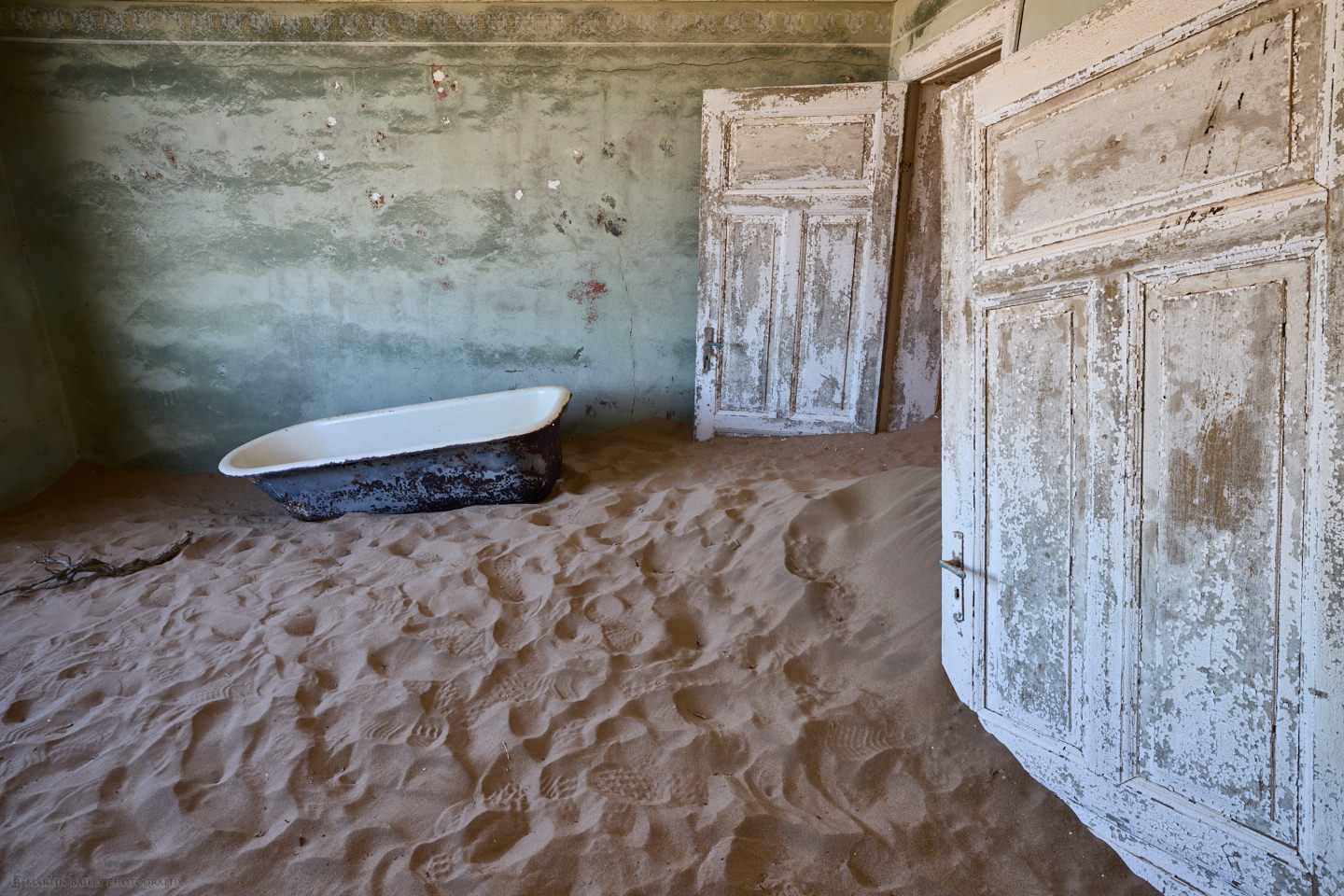
And here is a final shot from Kolmanskop for this series, and we see again, the door stuck in the sand, this time through a first door, with a second door in the background. We can also see here how the afternoon light was causing a bit of a problem with the highlights on the sand, but I do like the contrast between the light and dark, so again, I’m not too worried about this.
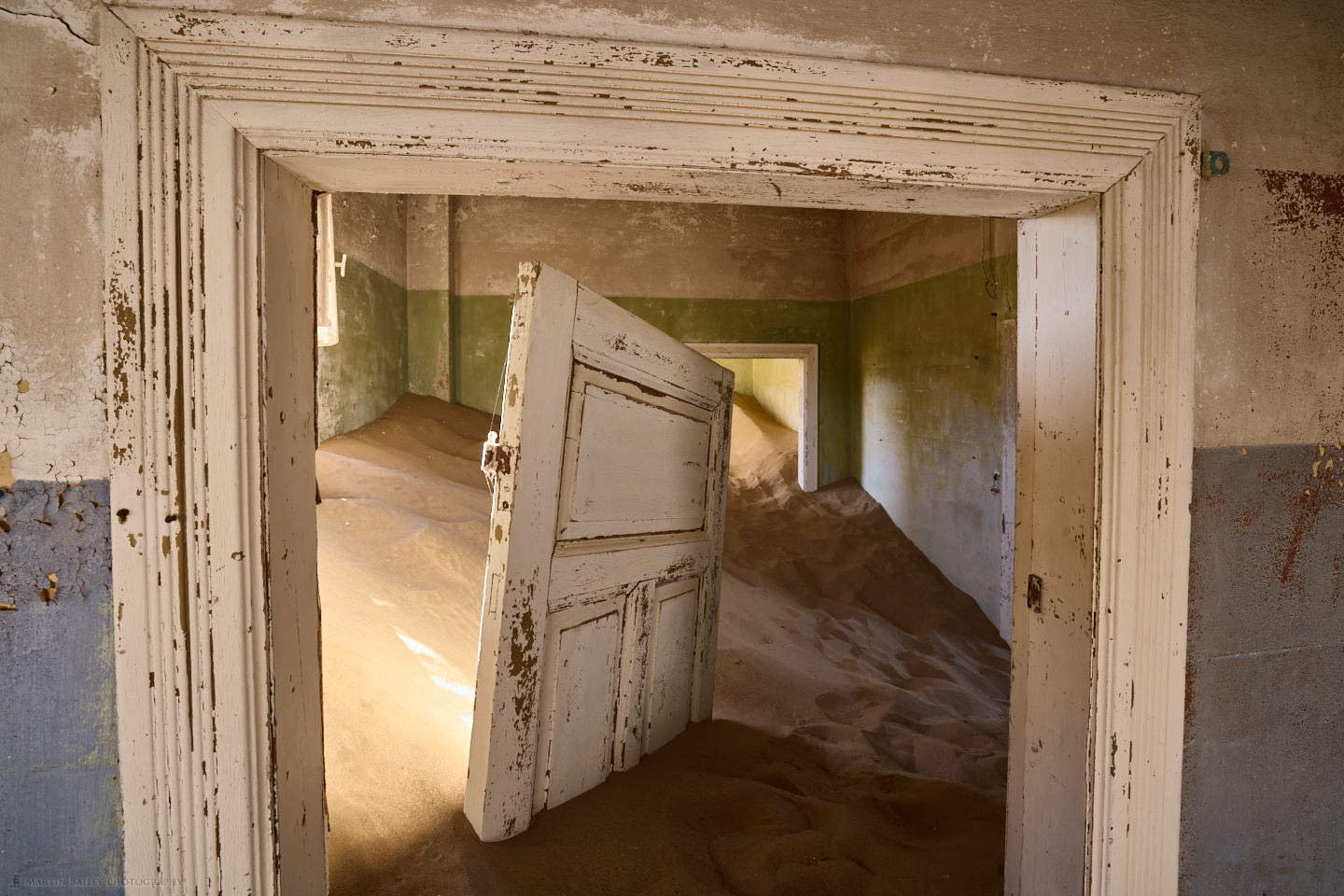
I was at least back on form with my camera settings by this point, with the ISO set to 100, for a 0.4-second exposure at ƒ/11. All of these shots were made with the Canon RF 15-35mm ƒ/2.8 L lens. Having bought this lens a couple of years ago to replace my EF 11-24mm lens when I switched to mirrorless, I hadn’t really given the RF lens much love until now, but love it I do, now that I’ve had a chance to really work with it. It’s an amazing lens, and although I thought I’d miss the extra 4 millimeters on the wide end, I really didn’t, so at this point, I am really happy with the decision to switch these lenses out. The extra aperture stop was also very welcome for the astrophotography that we do on this trip so all in all, a good decision.
We spend one more night in Luderitz, the city near Kolmanskop on the Atlantic coast of Namibia, then started our drive inland, then North to Sossusvlei, where we would spend the next three nights. We start to see a little more wildlife on that drive, and at one point, came across a matriarchal Ostrich looking after thirteen young Ostrich. The matriarch generally looks after all the young in their herd, with help from other females who may have contributed to the clutch. You can actually only see eleven of the thirteen chicks in this shot, as the other two were a little too far from the group for an effective shot.
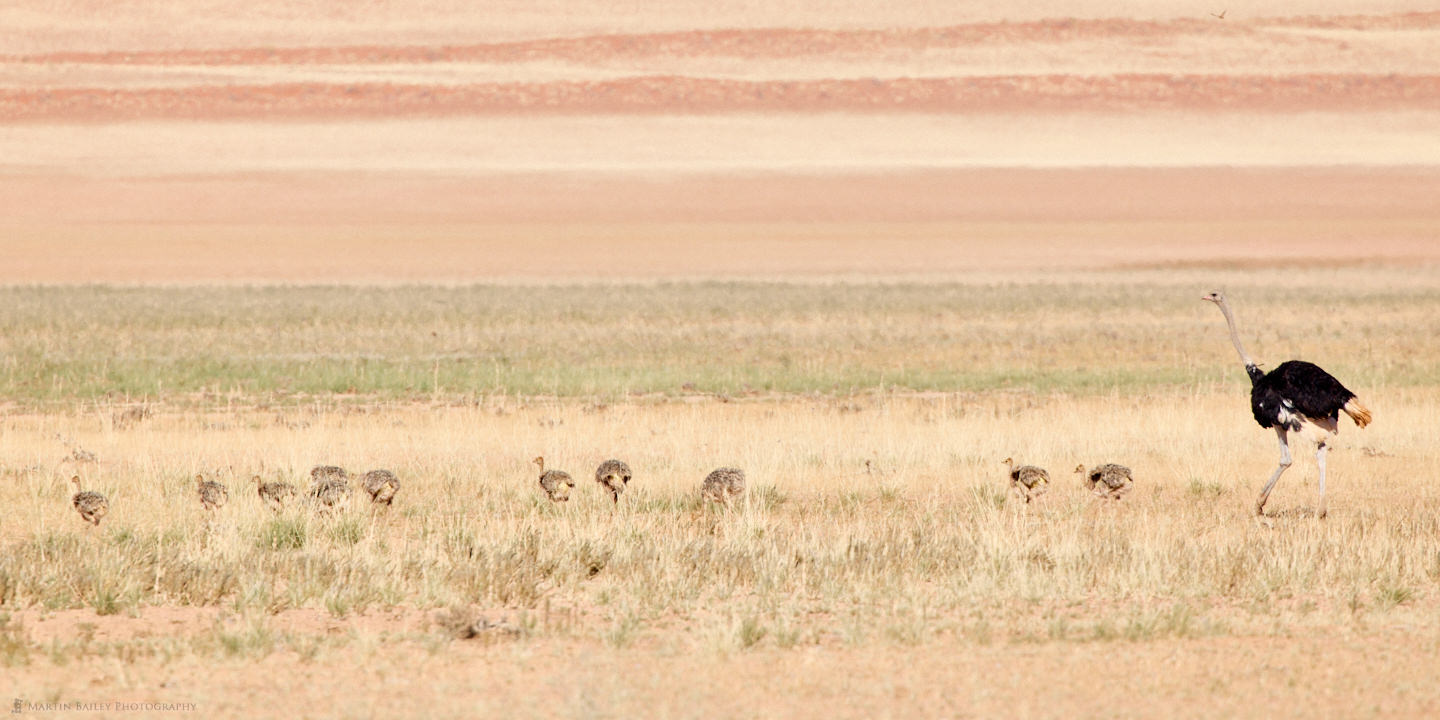
I cropped this down to a panorama partly to emphasize the width of the group of young ostrich, but also because we were shooting over the top of a fence, so the birds were naturally placed quite low in the frame, and the top of the frame added no real interest, so I got rid of it.
We saw multiple birds on the way as well, and I was able to get this shot as what I believe to be a Greater Kestrel landed on the top of the fence at the side of the road. It’s not the best shot, but I like the warmth of the scene and the dynamic pose of the kestrel.
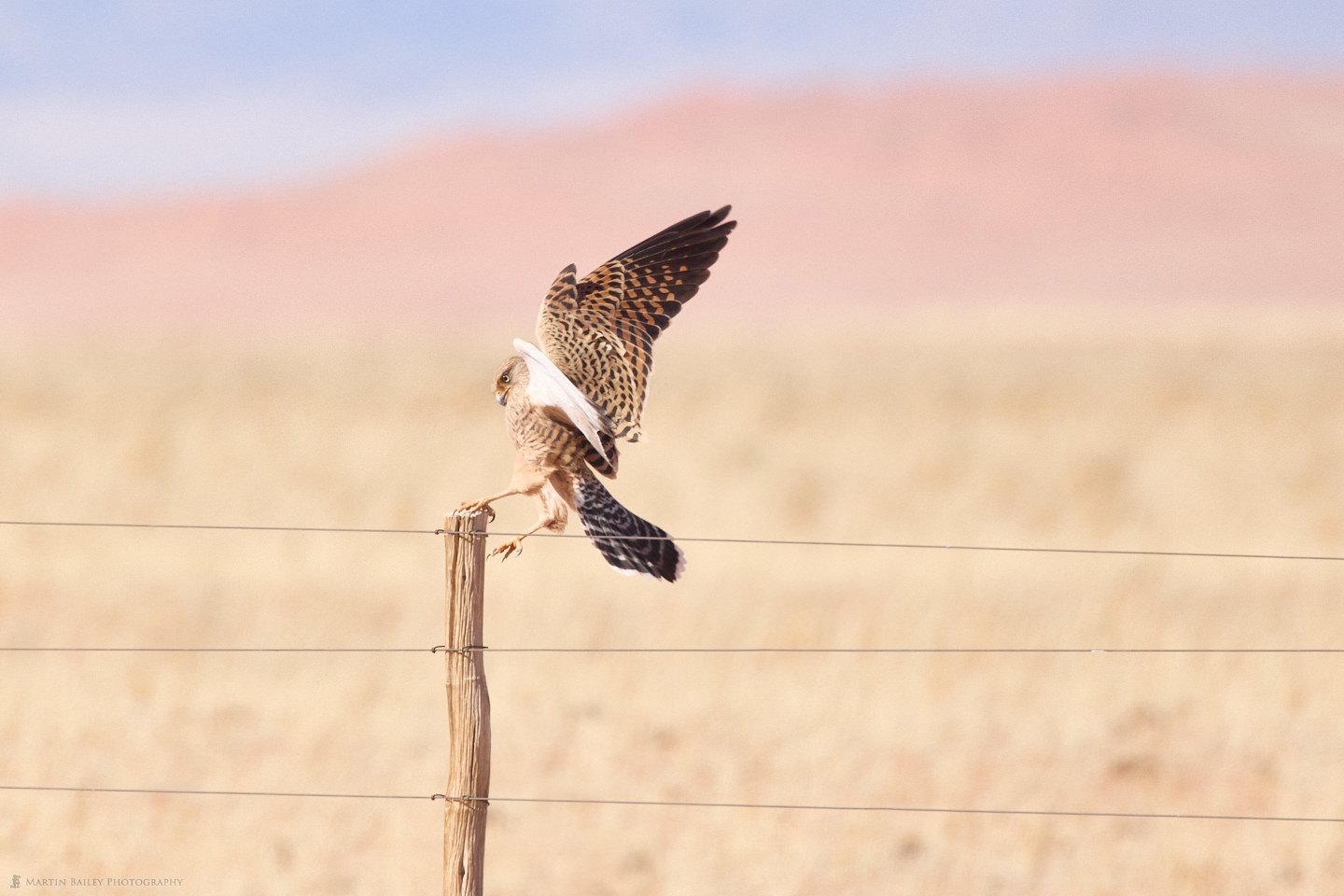
Pretty much in the same color palette, here we see an Oryx feeding in the long grass, and it was so nice to see all that grass during this drive. Namibia has just come out of a seven-year drought that has cost the lives of many farm animals as the farmers fought to find food and water for them. Some farmers paid out what money they had for food only to go on to lose the cattle anyway, as the drought worsened, so seeing the oryx standing in these huge open grass-covered planes was really reassuring.
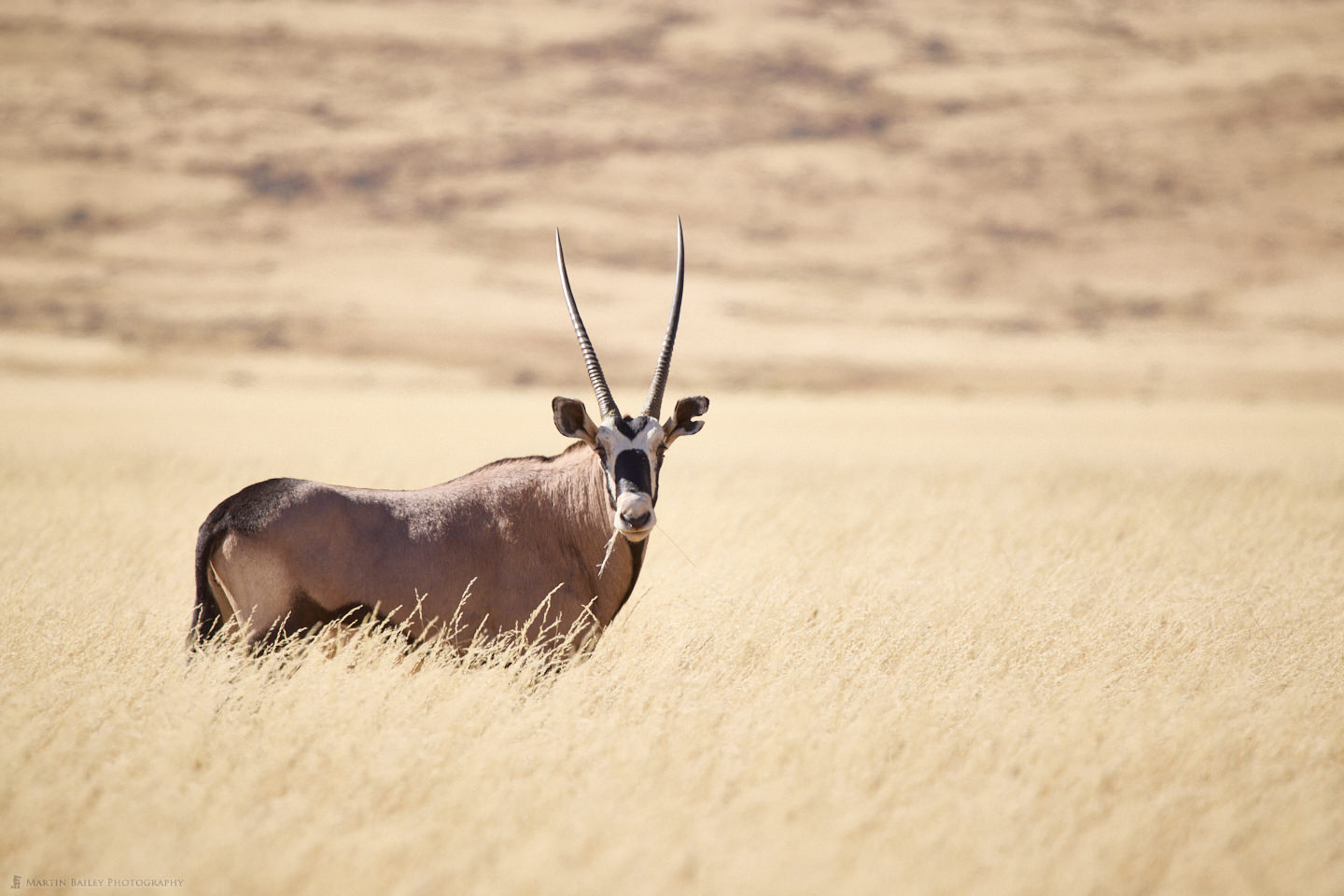
We entered the Namib-Naukluft National Park with about an hour to spare, so we drove down into the valley to the first dry river bed, seeing a number of Oryx and Springbok on the way. Just oryx shots aren’t much to write home about, but I do like it when we are able to get them in a nice environment, like this one with one of the sand dunes in the background, and the warm light just before sundown bathing them all.
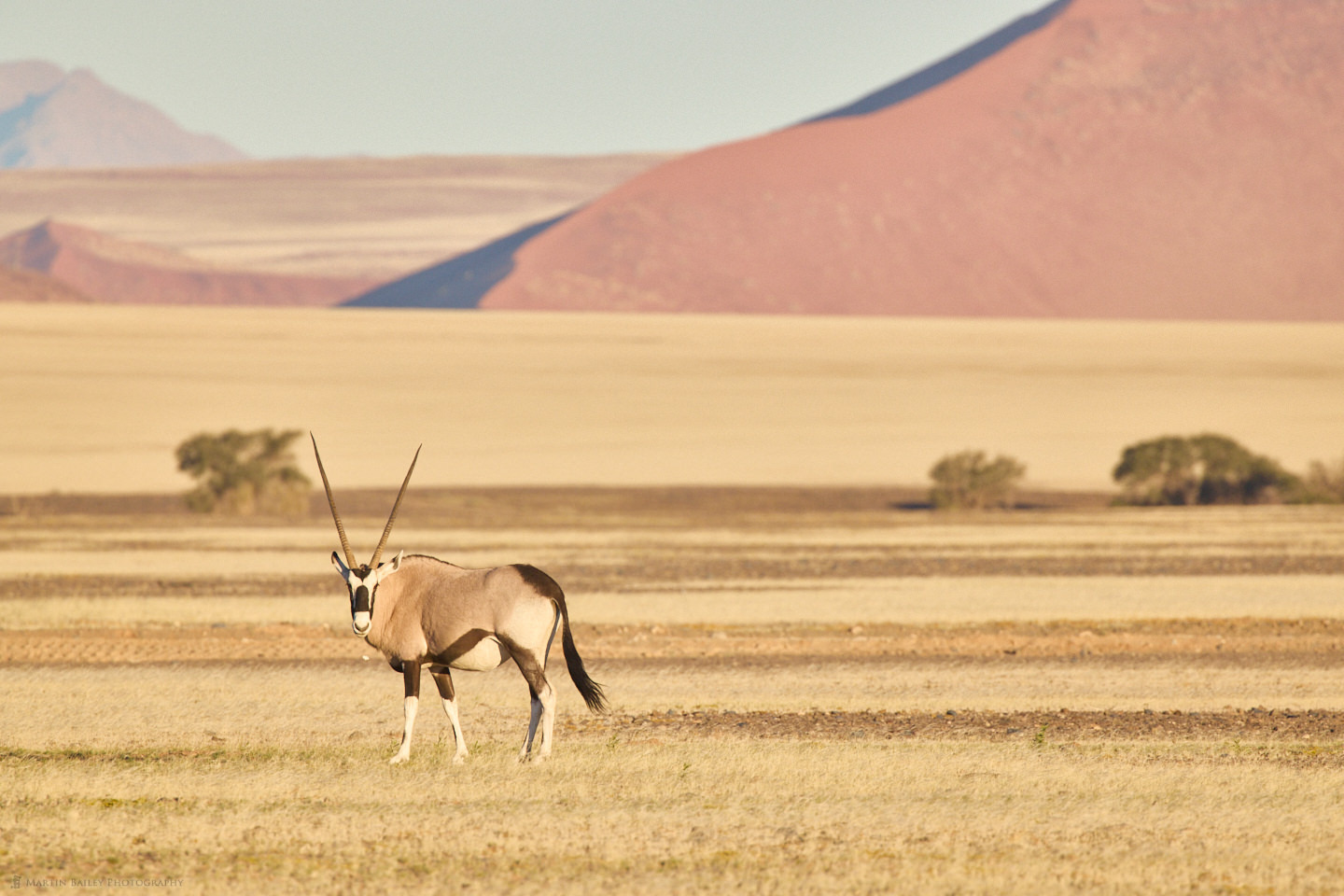
I shot this with the 100-500mm lens and the 1.4X extender for a focal length of 700mm. I’d set my camera up to be able to capture movement should it be required, so my ISO was at 1600 and my shutter speed 1/1000 of a second, at ƒ/11.
The following morning, up bright and early, we drove down to the car park near Deadvlei and walked into the iconic valley. There are now two new sand dunes that have formed in the mouth of the valley, so the walk gets the heart beating a little more than before, as do the additional corona pounds that I need to lose, but this spot is so worth the effort. After my three-year hiatus from Namibia, it also felt natural to go back to the first trees that I shot here for the first time in 2013, on my first visit.
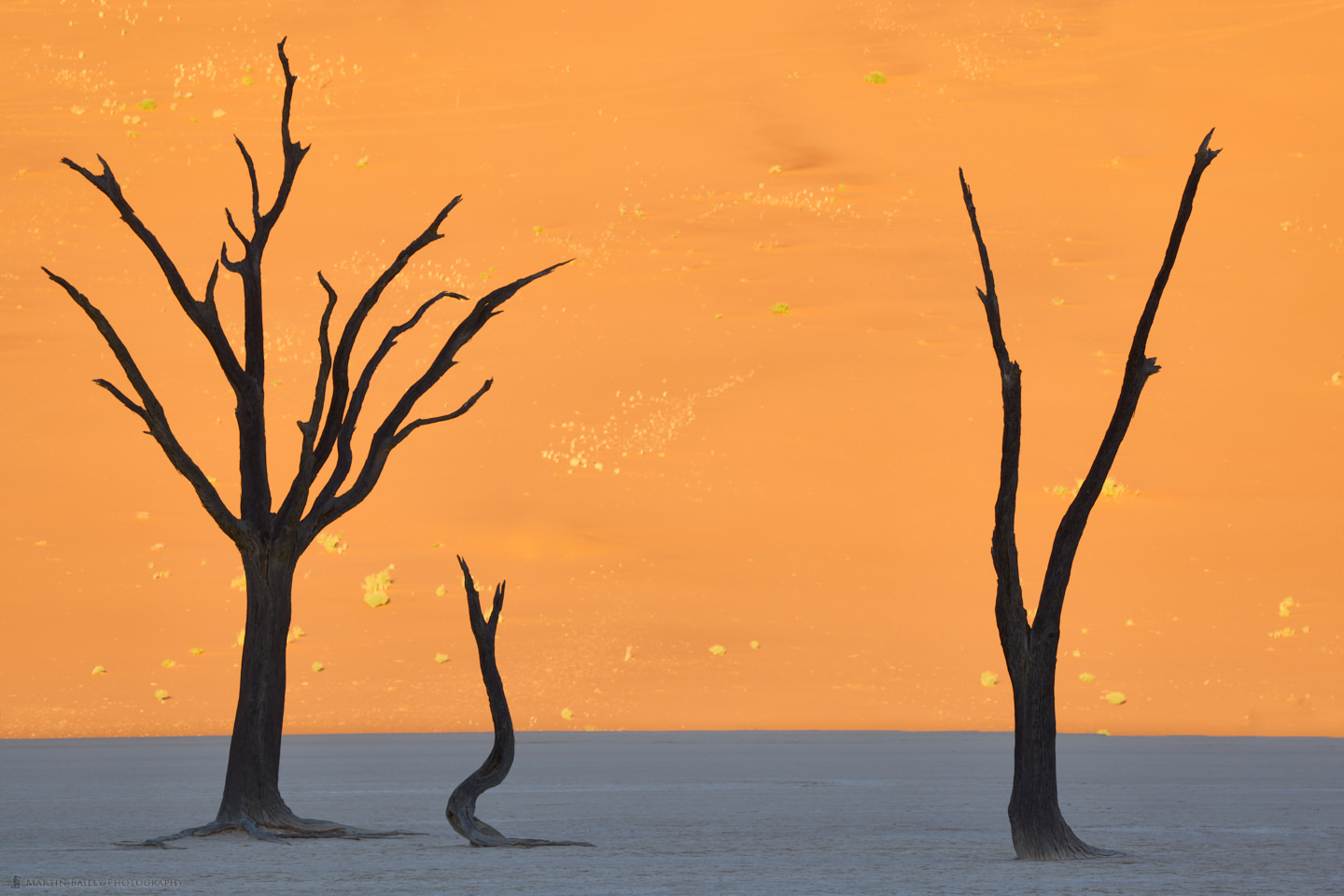
For anyone that doesn’t get what’s happening here, there is about a minute each morning when the sun has risen to the point where it is illuminating the sand dune that you see in the top four-fifths of this photo, but there is a sand dune to our backs, which casts a shadow across the clay basin, throwing the basin and the petrified camel thorn trees into shadow. That contrast makes the trees go almost black and the almost white clay remains a mid to dark gray color. This location was thrust into the limelight by National Geographic photographer Frans Lanting, and although I wasn’t aware of Lanting’s beautiful work on my first visit, I was kind of proud to find that the left two trees in my shot feature prominently on the right side of his iconic image.
This final image for this episode was shot at the end of the same day, when we walked to one of the dunes with some trees at its base. This is one of my favorites because of the trees, and the way the left side of the dune goes into shadow as the sun nears the horizon. It also made a nice change to see a bit of cloud in the sky here, as we don’t see that too often. I cropped this to a 16:9 aspect ratio to work better with the wide screen, as the additional bit of sky I had in my original wasn’t really adding anything.
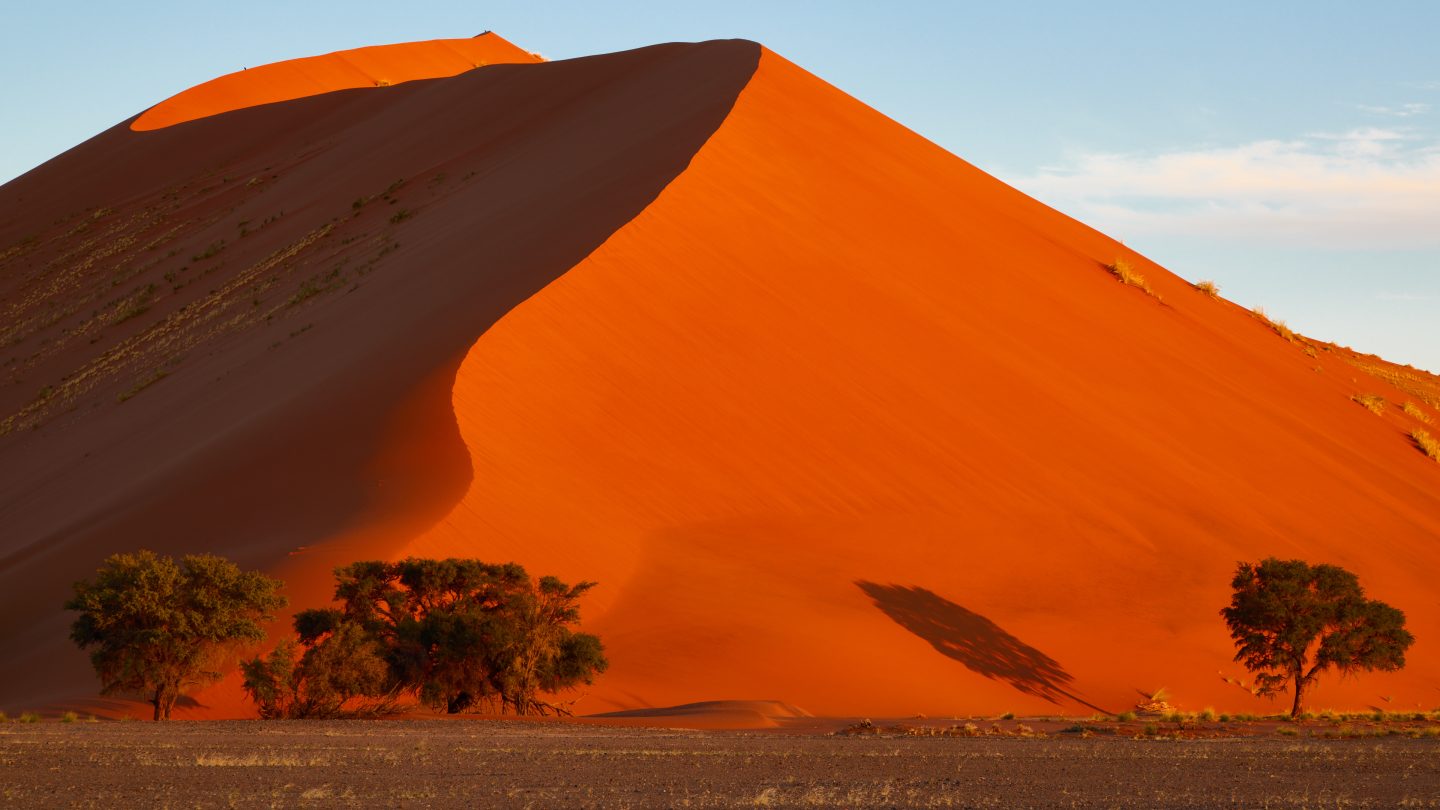
We’ll pick up the trail on our second morning in Deadvlei in a few days, as I am trying to pull in our three June episodes before the end of the month, so let’s catch up again in a few days.
Show Notes
Check out our tours page: https://mbp.ac/tours
Subscribe in iTunes to get Podcasts delivered automatically to your computer.
Download this Podcast as an MP3 with Chapters.
Visit this page for help on how to view the images in MP3 files.


0 Comments